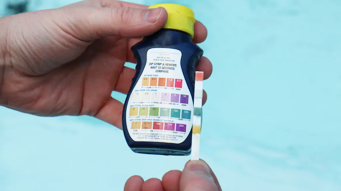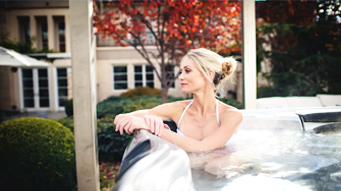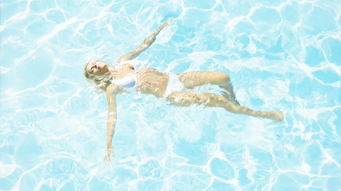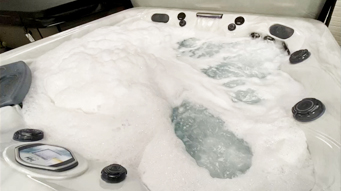How Do I Get My Hot Tub Ready For A Party?
It’s too good to miss! An opportunity to party and you have a hot tub, how do you prepare the water to be sparkling and inviting? It would be rude to invite your friends and not invite the hot tub wouldn’t it?
Hopefully, you have allowed yourself enough time between now and party-time to get the tub ship-shape.
Where shall we start? This depends on the condition of the water currently in the hot tub. How long has it been in there? Is it cloudy? Is it saturated? Does it look inviting?
If the water has been in there a while or the quality is not tip top, it may be worth changing it. Come party time, the water and the filters will possibly have to deal with and filter out considerably more contamination than it normally would, hence why the water needs to be prepared for it.
Let us assume that we need to change the water to enjoy the best bathing experience at party time.
When was the last time you carried out a hot tub flush to clean the hidden pipework and plumbing? It is worth considering carrying out this task now if it has been a while since it was last done.
Let’s break this down into a few simple steps.
1. Remove the filters and any floating sponges, Darlly Ducks, chemical dispensers etc.
2. Turn on the jets to max, or the cleaning cycle if available and add the liquid or gel cleaner.
3. Wipe down the inside of the tub to remove any residual film or grime.
4. Turn off the jets and the mains isolator before draining/pumping out the water.
5. Once the hot tub is completely drained and sponged out, start refilling with fresh water. Run the hose into the filter housing. This helps to fill the pipework first and can help avoid any airlocks in the system.
6. Fit new or previously thoroughly cleaned and dried quality Darlly filters. Also check out Darlly Sanistream and Darlly Silverstream filters for added benefits.
7. Fill the hot tub until the water is just above the highest jets by 30-50mm or your hot tub manufacturers recommendation. Test the water using test strips. Add some chlorine to boost the levels as the water is mains tap water.
To balance alkalinity and PH, wait until the water is up to normal hot tub temperature.
Remember to maintain floor cleanliness around the hot tub to reduce the possibility of treading contamination into the hot tub.
Add a Darlly duck or two to help collect the floating contaminants that always surface.
Arrange the party lights to add to the atmosphere and don’t forget your Darlly Cocktails to add a little extra pizazz to your hot tub!
Party on!
Happy Hot tubbing!
What’s the difference between chlorine and bromine?
First of all, why do we actually need chorine or bromine in our spa water? Good question!
Well, like it or not, hot tubs provide the ideal conditions for bacteria to grow.
There is a source of food (from the bathers), a lovely warm temperature (30-40c) and of course, moisture. Lots of it!
Bacteria and pathogens that can grow in the water include legionella, pseudomonas aeruginosa, mycobacterium and cryptosporidium. What can we do to prevent this?
We can use chlorine and bromine to prevent this growth.
Chlorine
Chlorine is the most popular sanitiser on the market. It is an affordable and effective method of sanitising a spa.
The ideal chorine level should be around 3-5mg/l (three to five milligrams per litre)
How does chlorine work I hear you ask? When chorine is dissolved, it creates hypochlorous acid. It is this that breaks down the bacteria in the water to create a safe and sanitised environment for bathing. Once the hypochlorous acid has broken the bacteria down, it becomes deactivated. This is called combined chlorine.
Combined Chlorine
The hypochlorous acid kills bacteria and it also reacts with sweat, urea and bather contamination (ammonia). Combined chlorine can cause skin and eye irritation and is responsible for the characteristic chlorine smell in pools and spas.
How do we deal with this? How can we reduce or remove combined chlorine from the water?
Reduce: UV, ozone, regular shock dosing, users taking a pre-bathing shower to remove contaminants.
Remove: Shock dose using an oxidiser.
Bromine
Bromine is an affordable and effective method of sanitising a spa or hot tub. Many people find that bromine has less odour and is kinder to the skin than chlorine.
The ideal bromine level for a domestic setting is 3-5mg/l and in a business setting around 4-6mg/l.
Again, the voice from the back asks ‘how does bromine work?’
When bromine is dissolved in spa water, it creates hypobromous acid. It is this acid that breaks down bacteria creating a safe and sanitised environment for bathing. After breaking down the bacteria, it becomes combined bromine and it still retains a small amount of sanitising effectiveness. The by-product is Bromamines, not as problematic and Chloromines but regular shocking is required to tackle it. This cannot be reactivated but the Bromine Ions in the water can be (which is what we add when dosing the product).
Combined bromine
When the hypobromous acid reacts with any organic content it is reduced back to bromide ions. Most, but not all, of these ions can then be reactivated back to hypobromus acid by adding an oxidiser. More bromide salt or ions need to be added periodically to make up the lost ions.
Brief summary
Chlorine v. Bromine
Properties Chlorine Bromine
Disinfection Effective at killing bacteria Effective at Killing bacteria
Cost ££ ££££
Shock dosing Needs regular shock dose to Needs regular shock dose to
remove combined chlorine. regenerate bromide ions
Benefits Cheap, accessible, easy to use Kind on skin and hair
It is worth noting that a bromine sanitised spa cannot be switched over to chlorine easily if there is still bromine in the water. All of the chlorine will be going to converting bromide ions into hypobromous acid. As long as there are 15 ppm or more of bromide ions in the water, none of it will provide a chlorine residual. The spa will continue to be bromine sanitised until the bromide level falls below 15 ppm. Unfortunately, there isn’t a test kit for measuring just bromide ions in the water and so it may take many many weeks. Draining and refilling may be the reliable option here.
How do I check and maintain the water quality in my hot tub?
How do I check the water quality and how often should I test it?
How important is it to check it? Let’s just have a brief run through the elements we need to monitor and then compile a quick go-to list to simplify it.

We need to check:-
1. Sanitiser – Chlorine or Bromine. Levels should be:- Free chlorine – 3-5ppm, Bromine 4-6ppm
2. Alkalinity. This should be between 80-120ppm
3. pH level – For chlorine users, this should be around 7.2 – 7.6. For bromine users it should be around 7.0 – 7.4. Values below these ranges indicate that the water is too acidic or if above, too alkaline both of which can have a negative impact on the effectiveness of sanitiser, water quality and can damage parts of the hot tub. The water can also cause irritation to eyes. High alkalinity can also cause the water to become cloudy.
4. Total Hardness. This is a measure of the dissolved minerals in the water, usually calcium and magnesium. Ideally, this should be between 100-250ppm. If the water is too hard , scale may form and the water may be cloudy. Tap water in the south east of the UK is hard water. Soft water may draw minerals from metal parts it is in contact with and cause damage.
5. Total Dissolved Solids (TDS). Chemicals, minerals, and other soluble materials can build up over time causing dull water and reducing the effectiveness of the chemicals used to maintain water quality. Testing should take place regularly every few weeks give or take depending on hot tub usage.
6. Bacteria. Your hot tub can provide bacteria with the ideal environment to thrive and grow. Bacteria test strips can test for E.coli, Pseudomonas aeruginosa and many other coliform and non-coliform bacteria, with the results in around 15 minutes. These strips are readily available at retailers and online.
7. Visually check water clarity and foaming. Check out our Filter Care topic ‘Hot Tub foam. What the bubble is going on?’
8. Check filters. These should be checked regularly for contamination, build up of dirt, sludge and other solids. Read our Filter Care Topic ‘How to clean a hot tub filter’ for more information.
It is arguably easier and more time-efficient to test regularly and treat accordingly working to maintain high water quality rather than ignore it until it drops to an almost irrecoverable quality.
To maintain the water quality – Most important is to reduce or remove sources of contamination, i.e., organic materials, suntan lotion, fake tan, make-up, contaminated bathing wear (detergent/ softener residue), soap, shampoo, body dirt, body oils, bather load, filter maintenance, cosmetics, food and drink spilled in and around the hot tub. These all add to the filter workload and all contribute to degrading the quality of the water that you bathe in.
Don’t allow contamination to enter the water in the first place, practice strict hygiene (shower before bathing etc), and ensure hair is clean and kept clear of the water.
Poor filtration through dirty, clogged or poor quality filters can cause milky or cloudy water, unpleasant odours and sanitiser levels to drop rapidly. Biofilm can also form on fixtures, in pipework and other areas where it cannot easily be seen. Not pleasant to bathe in!
Water balance – Balancing the water in your hot tub is the number one factor to maximising the life and appearance of your hot tub and water. Correct water balance ensures that the water is not scale forming or corrosive and will enhance your bathing experience. Balanced water ensures that the sanitiser works to maximum effect helping to protect the hot tub shell, equipment, water quality and enhance your hot tub experience.
To sum up in one list:-
1. Sanitiser
2. Alkalinity
3. PH level
4. Total hardness
5. Total Dissolved Solids (TDS)
6. Bacteria
7. Clarity and Foaming
8. Filters.
Hopefully, this information will help you to enjoy a wonderful hot tub experience with enticingly clear water
If you are looking for more information or have any suggestions for other hot tub Filter Care topics, please do not hesitate to get in touch. We will do what we can to help
Happy hot tubbing!!!
The Darlly Team
What is Hot Tub Foam? What the bubble is going on?
Help! The bubbles are taking over! The foam has landed! What the bubble is going on?
Let us understand what is creating the foam, why it is appearing, where it’s coming from and what we can do about it.
For foaming to occur, three components need to be present: Water, air, and surfactants. I think we all know what water and air are, but what are surfactants?
In short, surfactants lower the surface tension between two liquids or a liquid and a solid, which makes foaming easier and more likely to happen. (The actual chemistry of surfactants is complex, so so complex. Check out Wikipedia if you really want to know! !)
We know how the water gets into the hot tub and we know that air is introduced when the jets are on, but what about the surfactants? How do they get in there? There are three main ways:-
1. Personal care products. This can be virtually anything you use on or apply to your body or bathing wear. Soap, shampoo, conditioner, deodorant, hairspray, tanning, creams and moisturisers, lotions, makeup and washing detergent. The more of these that you use, the more you take into the hot tub with you.
2. Drinks and beverages. While it may be pleasant to sip your favourite tipple whilst enjoying your soak in the hot tub, (Hey, nothing wrong with that! ) spilt beverages, alcoholic or soft drinks, can upset the water and can lead to foaming.
3. Bodies People. Oh boy. Do we carry water contaminants into the tub with us?! Body fats, oils, dead skin cells, hair and the list goes on as you can imagine.
Obviously, more bodies and more regular hot tub use results in greater contamination that can overwhelm the chemicals in the water. The result? Increased risk of foaming!
We now know what causes foaming, so what can we do about it?
How to get rid of foam from a hot tub
We have a choice now. Do you need a quick temporary fix in time for the party tonight, delaying the inevitable remedy or are you ready to spend a little more time and do the job properly now?
Short-term quick temporary fix
If you need the short-term quick fix, adding a foam remover chemical can reduce/eliminate foam almost in the blink of an eye. It is worth remembering though that this is a temporary fix and does NOT address the underlying problem with the water quality, it is merely applying a temporary plaster to the problem. If this solution doesn’t seem to work, probably because of poor water quality and lack of regular water care, the only option now is to do the job properly……
Proper job
Well, this is the one. Drain the tub and start again to remove the cause of the foaming.
1. Test the water to find out the pH, alkalinity and sanitiser levels are. Also check the TDS (Total Dissolved Solids – the surfactants) to give you an idea of what the water chemistry is when foaming occurs. This can help you to understand the problem and how to help avoid the problem occurring again.
2. Drain the hot tub. Flush through the pumps and pipework with clean water and system flush cleaner and thoroughly clean the inside of the tub. It is vitally important to ensure that all traces of cleaner are removed! Don’t forget to replace the filters with new ones or with your second set that have been thoroughly cleaned properly and left to dry previously before fitting.
3. Refill the hot tub. Test the water, add your chemicals and allow to circulate. Test the water again to check that all is satisfactory. Enjoy!
How to reduce the possibility of foaming or avoid it altogether
Before bathing, have a seriously good shower to remove as much contamination and surfactants as possible. It is much easier than draining, cleaning and refilling the hot tub!
Bathing clothes should always be washed and then rinsed in clean water to remove all traces of detergent and conditioners etc. prior to enjoying the hot tub.
Hair should be washed and rinsed prior to hot tub use, otherwise avoid hair contact with the hot tub water.
Don’t spill drinks (or food!) into the water. Use cups with lids, or better still don’t drink in there!
Maintain the water quality. Regular water maintenance is essential.
Always use quality chemicals and water treatments. Cheap products may prove to be more expensive in the long run as you may need to use more of them which can itself be detrimental to water quality leading to more regular water changes.
Now you know what causes foaming, how to clear it and how to reduce or eliminate the risk of it occurring again.
All that is left for you to do now is enjoy your hot tub! Have fun!
Happy Hot Tubbing!
The Darlly Team



